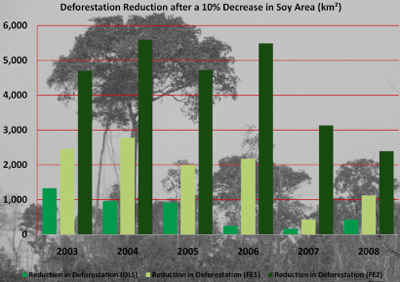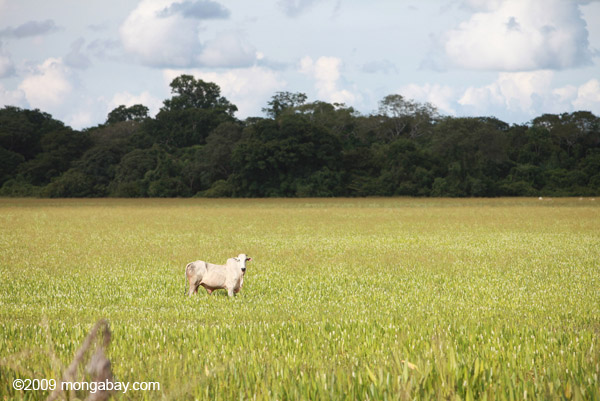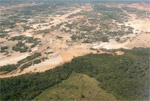Soy expansion in areas neighboring the Amazon rainforest is contributing to loss of rainforest itself, reports a new study published in Environmental Research Letters.
The research, which analyzed changes in forest cover across the 761 municipalities in the Brazilian Amazon, found that “deforestation in the forest frontiers of the basin is strongly related to soy expansion in its settled agricultural areas, to the south and east.”
The results indicate that indirect land use change (ILUC) is having a substantial impact on the Amazon rainforest. As mechanized soy farms encroach onto existing cattle pastures, ranchers are displaced into frontier forest areas, triggering deforestation.
 Deforestation reduction after a simulated 10% decrease in the expansion of soy production 2003–2008. Image and caption courtesy of Arima et al. (2011) |
The authors show that a relatively marginal increase in soy production in former pasture areas has caused a disproportionate amount of forest loss. Cattle ranching displaced by soy tends to be low-intensity and therefore requires large areas of land to be viable.
“Between 2003-2008 soy production expanded in Brazil by 39,000 square kilometers,” said Marcelus Caldas, an assistant professor of geography at Kansas State University who was a co-author of the study. “Of this 39,000 square kilometers, our study shows that reducing soybean production by 10 percent in these pasture areas could decrease deforestation in heavily forested counties of the Brazilian Amazon by almost 26,000 square kilometers — or 40 percent.”
The findings suggest that the Brazilian soy industry’s moratorium on new deforestation for soybean production — a result of a campaign by Greenpeace — may not be as effective as hoped.
 Since 1990, the cattle population in the Brazilian Amazon has grown from 25 million to more than 70 million, while the area of soy has expanded from from 16,000 sq km to more than 60,000 sq km (IBGE 2010). |
“The results thus call into question the effectiveness of the soy moratorium in reducing deforestation, and suggest that environmental policy in Brazil must recognize land use linkages in the agricultural sector of the economy,” the study states. “The results also suggest that supply chains crossing international boundaries may stimulate Amazonian deforestation via ILUC. That is, as global demands for Brazilian agricultural commodities grow, Amazonian deforestation may result by virtue of the process identified in this letter. Consequently, global efforts to reduce greenhouse gas emissions by substituting biofuels for petroleum products must proceed with care, in order not to intensify processes of Amazonian deforestation via ILUC, thereby undermining Brazil’s REDD objectives.”
Efforts to curtail deforestation in the Brazilian Amazon may similarly displace forest clearing to surrounding countries. Both Paraguay and Bolivia saw huge jumps in soy acreage during the study period.
CITATION: Eugenio Y Arima, Peter Richards, Robert Walker and Marcellus M Caldas. Statistical confirmation of indirect land use change in the Brazilian Amazon. Environ. Res. Lett. 6 (April-June 2011) 024010 doi:10.1088/1748-9326/6/2/024010
Related articles
Moratorium on Amazon deforestation for soy production proving effective
(03/06/2011) The Brazilian soy industry’s moratorium is proving effective at slowing deforestation for soy production in the Amazon rainforest, reveals a new study published in the journal Remote Sensing.
Brazil’s largest national bank signs zero deforestation pact for Amazon soy
(12/03/2010) Banco do Brasil, Brazil’s largest state-owned bank, announced it has joined a zero deforestation pact for soy grown in the Amazon. The bank will now require farmers applying for credit to certify the origin of their soybeans.
Corporations, conservation, and the green movement

(10/21/2010) The image of rainforests being torn down by giant bulldozers, felled by chainsaw-wielding loggers, and torched by large-scale developers has never been more poignant. Corporations have today replaced small-scale farmers as the prime drivers of deforestation, a shift that has critical implications for conservation. Until recently deforestation has been driven mostly by poverty—poor people in developing countries clearing forests or depleting other natural resources as they struggle to feed their families. Government policies in the ’60s, ’70s, and ’80s had a multiplier effect, subsidizing agricultural expansion through low-interest loans, infrastructure projects, and ambitious colonization schemes, especially in the Amazon and Indonesia. But over the past two decades, this has changed in many countries due to rural depopulation, a decline in state-sponsored development projects, the rise of globalized financial markets, and a worldwide commodity boom. Deforestation, overfishing, and other forms of environmental degradation are now primarily the result of corporations feeding demand from international consumers. While industrial actors exploit resources more efficiently and cause widespread environmental damage, they also are more sensitive to pressure from consumers and environmental groups. Thus in recent years, it has become easier—and more ethical—for green groups to go after corporations than after poor farmers.
How Greenpeace changes big business

(07/22/2010) Tropical deforestation claimed roughly 13 million hectares of forest per year during the first half of this decade, about the same rate of loss as the 1990s. But while the overall numbers have remained relatively constant, they mask a transition of great significance: a shift from poverty-driven to industry-driven deforestation and geographic consolidation of where deforestation occurs. These changes have important implications for efforts to protect the world’s remaining tropical forests in that environmental groups now have identifiable targets that may be more responsive to pressure on environmental concerns than tens of millions of impoverished rural farmers. In other words, activists have more leverage than ever to impact corporate behavior as it relates to deforestation. A prime example of this power is evident in a string of successful Greenpeace campaigns, which have targeted some of the largest drivers of deforestation, including the palm oil industry in Indonesia and Malaysia and the soy and cattle industries in the Brazilian Amazon. The campaigns have shared a common approach: target large, conspicuous consumer-facing companies that sell in western markets.
Amazon soy moratorium extended
(07/08/2010) Brazilian soy farmers have extended their moratorium on Amazon deforestation for another year, reports Greenpeace.
Ending deforestation could boost Brazilian agriculture

(06/26/2010) Ending Amazon deforestation could boost the fortunes of the Brazilian agricultural sector by $145-306 billion, estimates a new analysis issued by Avoided Deforestation Partners, a group pushing for U.S. climate legislation that includes a strong role for forest conservation. The analysis, which follows on the heels of a report that forecast large gains for U.S. farmers from progress in gradually stopping overseas deforestation by 2030, estimates that existing Brazilian farmers could see around $100 billion from higher commodity prices and improved access to markets. Meanwhile landholders in the Brazilian Amazon—including ranchers and farmers—could see $50-202 billion from carbon payments for forest protection.
Large-scale soy farming in Brazil pushes ranchers into the Amazon rainforest
(04/28/2010) Industrial soy expansion in the Brazilian Amazon has contributed to deforestation by pushing cattle ranchers further north into rainforest zones, reports a new study published the journal Environmental Research Letters.